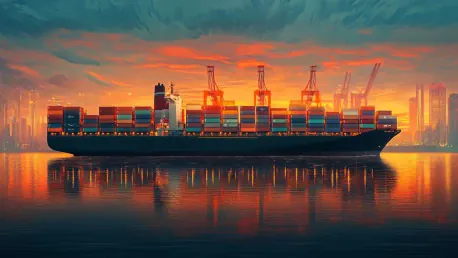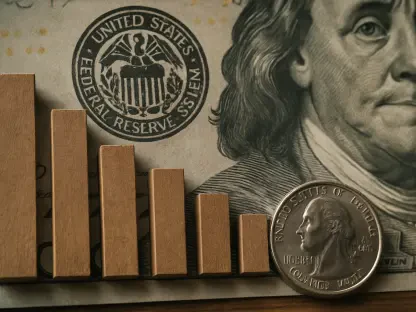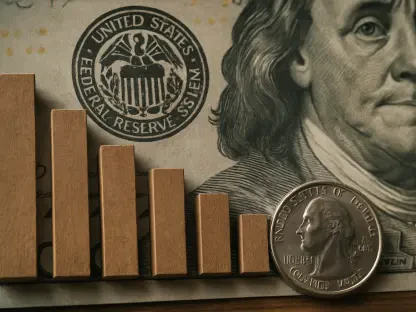The return of Donald Trump to the U.S. presidency has been marked by bold economic policy shifts, particularly through the imposition of substantial tariffs. These policies rekindle concerns over their potential disruptions to global economic stability. This outline explores the multifaceted impacts of Trump’s tariffs on both the U.S. and international economies.
Introduction of Tariffs
Trump’s reintroduction of significant tariffs targets several key trading partners and industries. His administration announced a 25% tariff on imports from Canada and Mexico, 20% on Chinese goods, and 25% on steel and aluminum imports. These measures aim to protect American industries by creating a competitive advantage for domestic manufacturers. Such a strategy is designed to shift global trade dynamics and encourage local production.
However, the implementation of these tariffs has been less than straightforward. Trump’s erratic communication style, particularly through his preferred social media platform, “Truth Social,” has added to market uncertainties. Frequent delays and sudden changes in tariff policies have created an environment of unpredictability, making it challenging for businesses and investors to plan effectively.
The inconsistency in policy announcements has caused confusion among industry stakeholders. Companies and government entities worldwide have struggled to adapt to the rapid changes and lack of clear direction. This erratic approach towards policy implementation has not only shaken market confidence but also impacted the overall economic landscape.
Market Instability and Investor Confidence
The unpredictability associated with Trump’s tariff announcements has caused significant turbulence in the financial markets. Investors, who rely on stable and predictable policies, are left grappling with fluctuating expectations. This instability directly impacts their confidence, leading to increased market volatility and a hesitancy to make long-term investments.
Since mid-February, U.S. share prices have dropped by approximately 10%, reflecting the market’s sensitivity to Trump’s policy decisions. Such a decrease underscores investors’ apprehensions about potential inflation, economic recession, and the broader economic impact of these tariffs. The financial markets, which thrive on predictability and stable growth prospects, find themselves at odds with the erratic nature of policy announcements.
This volatility is particularly concerning for industries reliant on international trade. Companies face increased risk as they navigate the complexities of changing tariffs, which can alter supply chain dynamics and cost structures. For investors, the unpredictability translates into higher risk premiums and a cautious approach to capital allocation.
Inflation and Consumer Costs
The imposition of tariffs traditionally leads to higher consumer prices, as the added costs are often passed down the line. Historical evidence suggests that tariffs contribute significantly to inflation by increasing the price of imported goods. Consumers, who ultimately bear the burden of these tariffs, experience a rise in everyday costs.
Recent data highlights the early effects of Trump’s tariff policies on American consumers. The University of Michigan consumer sentiment survey illustrates a sharp increase in inflation expectations, rising from 3.2% to 3.9%. This stark rise reflects the pervasive concern among consumers regarding the cost implications of these tariffs.
As consumer prices climb, inflation becomes a pressing issue. Increased costs for essential goods and services strain household budgets, reducing disposable income and impacting overall economic activity. The consumer price index, often used to measure inflation, provides a clear indicator of the economic strain placed on average citizens.
Moreover, industries such as automobiles, semiconductors, and pharmaceuticals face significant challenges due to heightened production costs. With tariffs affecting key components and raw materials, manufacturers are forced to adjust pricing strategies, leading to higher retail prices. The cumulative effect of these adjustments underscores the widespread economic impact, extending beyond direct import costs.
Business Investment and Employment
The ripple effects of tariffs extend to critical areas like business investment and employment. Companies grappling with the unpredictability of tariff policies find it challenging to make informed decisions about capital investments. The uncertainty surrounding future costs and supply chain disruptions creates a cautious approach toward expansion and development.
Many businesses are hesitant to undertake new capital investments or hire additional staff due to the unpredictable economic environment. The costs associated with tariffs affect profit margins and overall financial health, making it risky to commit to long-term projects. The fear of sudden policy changes exacerbates these concerns, stunting economic growth and innovation.
Manufacturers face higher production costs as access to cheaper foreign inputs diminishes. Industries reliant on imported raw materials must navigate increased costs, impacting their competitiveness and potential for growth. Export opportunities also become limited due to retaliatory tariffs, further complicating the business landscape.
The employment sector is not immune to these effects. Companies, wary of economic instability, may delay hiring plans or reduce workforce numbers to mitigate risks. This caution leads to slower job creation, impacting overall employment rates. The broader economic consequences extend to reduced consumer spending and lower economic activity.
Economic Activity Projections
Economists predict that the cumulative impact of these tariffs could shrink U.S. economic activity by -0.3% over the next three years. These projections depict a challenging economic landscape, where growth is hampered by trade barriers and increased costs.
Country-specific analyses further illustrate the widespread ramifications of Trump’s tariffs. Major trading partners, including Canada, Mexico, and China, are expected to face significant economic downturns. The potential GDP declines projected for these countries highlight the interconnected nature of global trade and the ripple effects of tariff policies.
The economic activity projections underscore the importance of stable and predictable trade policies. The uncertainties created by frequent tariff changes disrupt economic planning and forecasting. Businesses and governments must adapt to these new dynamics, often at the cost of growth and development.
For the U.S., the decline in economic activity correlates with reduced consumer spending, lower business investments, and stunted job creation. These factors collectively contribute to a more subdued economic outlook, where growth potential is limited by external trade barriers and internal policy fluctuations.
Broader Economic Agenda
Trump’s economic policies extend beyond tariffs, encompassing significant changes in immigration, fiscal policies, and regulations. These broader agenda items further complicate the economic outlook, adding layers of uncertainty and unpredictability.
One notable aspect is Trump’s promise of mass deportations, which could drastically reduce the U.S. labor force. Businesses reliant on immigrant labor would face significant operational challenges, affecting productivity and profitability. The reduction in labor availability would likely exacerbate inflation risks, as companies struggle to fill workforce gaps.
Fiscal policy changes also contribute to the economic uncertainty. Trump’s administration has indicated intentions to reform government spending, aiming to cut costs through various initiatives. These changes, while potentially beneficial in reducing national debt, pose risks to economic stability if not managed effectively.
The combination of immigration reforms and fiscal policy shifts creates a complex and unpredictable economic landscape. Businesses must navigate these changes while adapting to the ongoing impacts of tariffs. The cumulative effect of these policies shapes a challenging environment for long-term planning and growth.
Government Efficiency Initiatives
Within Trump’s administration, the Department of Government Efficiency (DOGE), led by Elon Musk, seeks to cut government spending by identifying and eliminating fraud. This initiative represents an ambitious effort to streamline government operations and reduce fiscal burdens.
However, the effectiveness of these efforts remains contentious. Experts argue that significant savings through fraud elimination are difficult to achieve without substantial evidence supporting the initiatives. The lack of concrete data raises doubts about the long-term viability and impact of these efficiency measures.
The pursuit of government efficiency, while noble in principle, requires careful execution and transparent reporting. The ambitious goals set by DOGE must be matched with actionable strategies and measurable outcomes. Without substantial proof of savings, the initiatives risk falling short of their intended impact.
This approach to government spending, combined with the economic uncertainty created by tariffs and other policy changes, further complicates the broader economic outlook. Businesses and investors must factor in the potential for policy shifts and efficiency measures when planning for the future.
Deregulation and Economic Stability
Trump’s executive orders mandate the repeal of existing regulations, aiming to foster economic growth through deregulation. This approach, while intended to reduce bureaucratic red tape, poses risks to long-term economic stability.
The abrupt changes in regulatory frameworks create an environment of uncertainty for businesses. Companies must adapt to new regulations while navigating the impacts of repealed policies. This volatile landscape complicates long-term planning, investment decisions, and operational strategies.
The cumulative effect of deregulation efforts generates additional uncertainty for industries. Businesses may find it challenging to comply with changing regulations, impacting their ability to operate efficiently. The unpredictability associated with deregulation hinders investment and innovation, potentially stunting economic growth.
While deregulation aims to stimulate economic activity by reducing constraints, the approach requires a careful balance. Long-term economic stability relies on predictable and consistent regulatory environments, where businesses can plan and grow with confidence. The current landscape of frequent regulatory changes complicates this balance, creating challenges for sustainable growth.
Global Political Implications
Trump’s impulsive decision-making style poses risks not only to global economic stability but also to America’s political leadership. The international community watches closely as these policies take shape, considering the potential for strained trade relationships.
The implementation of aggressive tariffs and other policy changes has already impacted global trade dynamics. Countries affected by these measures may respond with retaliatory tariffs, further complicating international trade relationships. The geopolitical stakes associated with Trump’s tariff strategy are significant, highlighting the far-reaching implications.
The broader global political implications include potential shifts in alliances and partnerships. As countries navigate the impacts of U.S. tariffs, they may seek new trade agreements and collaborations to mitigate adverse effects. These changes underscore the importance of stable and predictable international trade policies.
The international community’s response to Trump’s tariffs provides insight into the geopolitical landscape. The delicate balance of global trade relationships requires careful consideration and strategic planning. Trump’s erratic approach towards policy implementation challenges this balance, creating a complex environment for global economic stability.
Conclusion
The return of Donald Trump to the U.S. presidency has been marked by significant shifts in economic policy, particularly through the implementation of substantial tariffs. These actions have brought back concerns about their potential impact on global economic stability. Historically, tariffs have been used as a tool to protect domestic industries from foreign competition, but they also risk igniting trade wars and increasing costs for consumers and businesses.
Trump’s tariffs aim to encourage companies to produce goods within the U.S. by making imported products more expensive. However, this approach can lead to higher prices for consumers and disruptions in supply chains, affecting everything from electronics to clothing. In the international arena, these tariffs could lead to retaliatory measures from other countries, potentially harming global trade relationships and economic growth.
This exploration delves into the complex effects of Trump’s tariff policies on both the national and international economies. It considers the potential benefits to American manufacturers and workers, as well as the broader consequences for global trade and economic harmony. By assessing the various facets of this economic strategy, we gain a deeper understanding of its far-reaching implications.









